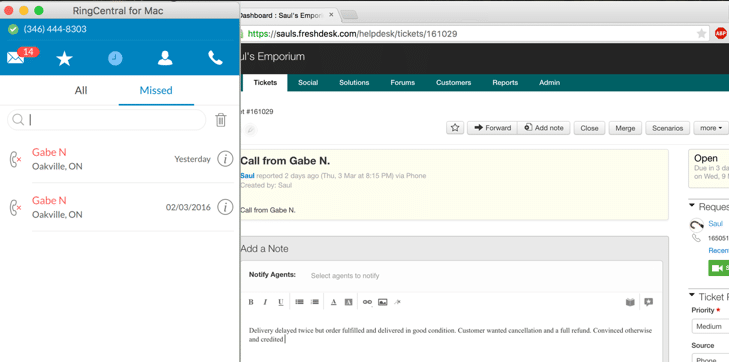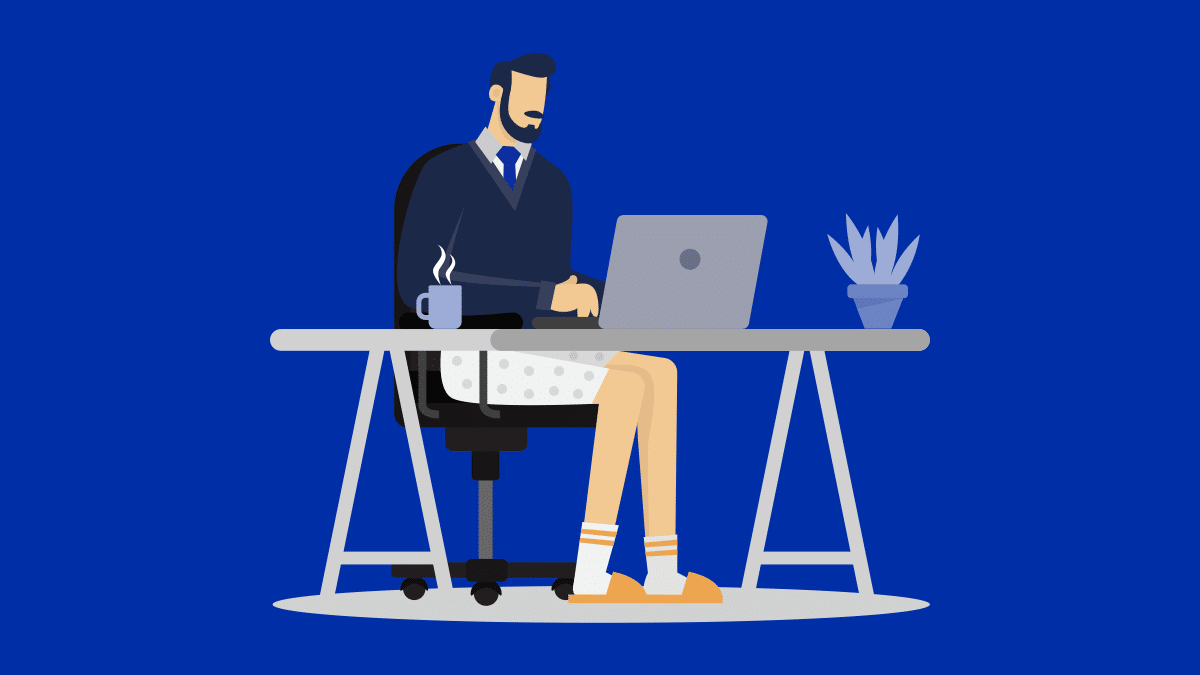It’s easy for small businesses to lose track of all their customer support conversations—questions, complaints, follow-ups—across their various different channels, from chatbots to emails to social media. But why?
Simply put, if you’re trying to grow a small business, you’re probably pressed for time and resources. Even if you’re one of the lucky few who has more than one person on hand to deal with customer service queries, it can soon get overwhelming as your business expands—so your employees will need to wear many different hats in order to keep up.
There is some good news, however. Namely, that there are ways to provide an outstanding customer experience while easing the burden on your employees. One of the most effective ways to make life easier for a small and overworked customer service team is to invest in the best customer service software ecosystem.
Thankfully, there’s plenty of customer service software that should be within the financial reach of the typical small business owner. In this guide, we’ll look at some of it, covering the following key areas:
- The importance of customer service
- What are “customer service solutions” and why do they matter?
- Different types of customer service software
- 6 powerful customer service solutions for your business, categorized by type
- How to choose the right customer service tools for your business
We’ll pay particular attention to how RingCentral’s products can help you provide an even better standard of customer service. Let’s get started.
⭐️⭐️⭐️⭐️⭐️ Ready to offer 5-star customer service? Get strategies for every stage of the customer journey with this free eBook.
The importance of customer service
Unlike big-box companies and corporations, there’s little room for error when it comes to small business customer service. Every new client who walks through the door could make, or break, your success.
This is doubly true today in the “Experience Economy,” when customers value a positive experience even over price. While this might seem daunting, it’s actually good news for small businesses. It means you can compete head-to-head with huge companies, even if they undercut you on price.
What are “customer service solutions” and why do they matter?
In short, customer service solutions help companies track, organize, and address customer issues and questions.
Typically, these programs include functionality such as live chat and ticket management, but the very best apps and tools allow your company to meet its customers where they truly are. This enables you and your customer support team to take an omnichannel approach, managing phone calls, emails, chats, SMS, social media interactions, and more—and all from a single platform.
In choosing the best customer support software for your business, there are some clear benefits you should be looking for. These include the following:
- Free up time: A lot of customer service tools can enable you to cut down on some of the more repetitive, manual tasks. For instance, they can help scout different channels for incoming customer requests, complaints, and questions.
- Personalize interactions with customers: Customer service software can act as a database that lets you keep track of customer details. So imagine how much more personalized your conversations with customers could be when you’re aware of their names, past interactions, and even their preferred communication channels.
- Improve collaboration: From managing tasks to holding video meetings, a good customer service app will make it easier for you to brainstorm with your team and provide seamless customer service.
- Analyze performance: Can you see the trends and results of your efforts? Your chosen customer service software should be able to provide you with this data, along with call center metrics.
Need to see it in action? Here’s a closer look at RingCentral Engage Digital, an all-in-one customer service software that small businesses love:
3 types of customer service software
Customer service software—and most importantly, their features and benefits—usually fall into the three categories listed below:
1. Communication software
A call center covers a lot more than phones these days. This is usually the software that lets you serve your customers via text, phone, email, chat, and video messages. The best communication tools bring everyone in your team together in a single platform—often, also with screen sharing, file annotation, and message alerts.
Learn more about how to provide good online customer service.
2. Help desk / ticketing software
Help desk or ticketing systems allow you to track customer interactions through support tickets. These tickets are essentially interactive records that provide a holistic view of every customer support request, making it easier for you to monitor and resolve more complicated issues.
Invite multiple team members to your help desk software to collaborate on customer service tasks.
3. Live chat software
Like an instant messaging app, live chat software lets you interact directly with customers in real time. This usually happens through a set of predefined rules set up in the software application.
One of the most common rules involves people who’ve browsed a certain page for a specific period. The software will automatically present them with a prompt inviting them to ask you any questions they may have.
More modern live chat tools also let you do things like route chats, send canned responses, and create custom forms to collect your visitors’ information.
Now, let’s look at a few tools in each of these categories, along with how they can help enhance the customer experience.
6 powerful customer service solutions for small businesses
With so many different customer service software tools to choose from, you might be wondering where to begin with it all. As a hardworking small business owner, you no doubt have plenty of things on your plate at any given time—so you probably haven’t got time to spare to sift through the various options available to you.
Thankfully, we’re on hand to do that job for you, saving you the hassle. We’ve done the hard work on your behalf, narrowing it down to six of the very best options—two communication software tools, two help desk software tools, and two live chat software tools.
What’s more, it’s perfectly possible—and hugely beneficial—to combine the tools as part of a holistic ecosystem. By putting them to work in tandem you can supercharge each one, and deliver the kind of customer experience many small businesses can only dream about. Let’s examine them in more detail.
Communication software
1. RingCentral
There’s a reason RingCentral won PCMag’s Editors’ Choice in business communications. With HD video and cloud phone service, and solutions that keep all your customer interactions in one place, RingCentral makes it easy to work together as a team to provide good customer service.
Bonus: Contact center software
Want to take control of your customer experience on WhatsApp—while tracking questions that are coming in through Facebook Messenger? You can use RingCentral’s tightly integrated customer engagement features to get it done.
RingCentral’s contact center product can help you boost your first contact resolution rate, tackle messages across multiple communication platforms, and make sure your whole team is looking at the same customer information. Here’s a quick clip of how it works:
If you want to prioritize requests from your VIP customers, you can do that through RingCentral’s integrations with leading CRM (customer relationship management) tools. This lets you tag sensitive or special customers so that automatic distribution systems deliver their requests at the front and center of the support queue.
RingCentral is also equipped with features that give you insights into customers’ perception of your business. For example, you can use customer surveys to identify trends in service that pop up over time. Use the platform’s integrated messaging features to circle up with your team and decide what needs to improve based on those trends: The social media service quality? The call response time? The chat prompts? Everything? (Heads up: it’s pretty often “everything.”)
🕹️ Get a hands-on look at how RingCentral works by booking a product tour:
💰 You can also use this calculator to see roughly how much your business could save by using RingCentral to support your team’s communications with clients, customers, and each other.
2. HubSpot Service Hub
Much like RingCentral, HubSpot Service Hub lets you access your call, chat, and email interactions all in one place in a user-friendly system.
Each interaction is enriched by the integrated CRM, so you get contextual information about the customer’s journey with your business. Plus, the built-in help desk allows you to turn chats and emails into tickets that can be easily tracked, structured, and prioritized.
HubSpot Service Hub can also be used to automate customer marketing emails, collect customer feedback via surveys, and conduct 1:1 screen-sharing sessions with customers. You can even integrate it with HubSpot’s marketing and sales software to generate leads for your business. Overall, it’s a decent communication tool to use if you’re looking to up your customer service game.
Of course, you’d still need to connect it with a fully featured communication tool like RingCentral if you want to access certain features like HD video conferencing with in-meeting chat (HubSpot’s own tool only lets you create 1:1 screen-sharing videos to send via support tickets):
Help desk/ticketing software
3. Freshdesk
Trusted by over 150,000 businesses, Freshdesk lets you streamline conversations from across channels so that you can identify trends and assign tickets accordingly. Unlike other customer service tools, this help desk software also has a few features for team productivity and internal collaboration. These include team inboxes to collectively manage your most important tickets, canned responses for common support requests, and the ability to split tickets with various tasks into sub-tickets so that multiple teams can work on them in unison. How’s that for customer service teamwork?
The tool is also equipped with AI features that allow you to do away with repetitive, mundane tasks. For example, you can configure its support bot (named Freddy) to assist your customers by answering FAQs via chat and email. Need to automate escalations and other tasks using specific event-based triggers? You can do that too.
And oh look, you can integrate Freshdesk with RingCentral too. There’s the automatic call logging feature, where Freshdesk automatically generates a support ticket with all the relevant customer details attached once you finish a call using RingCentral.
4. Kayako
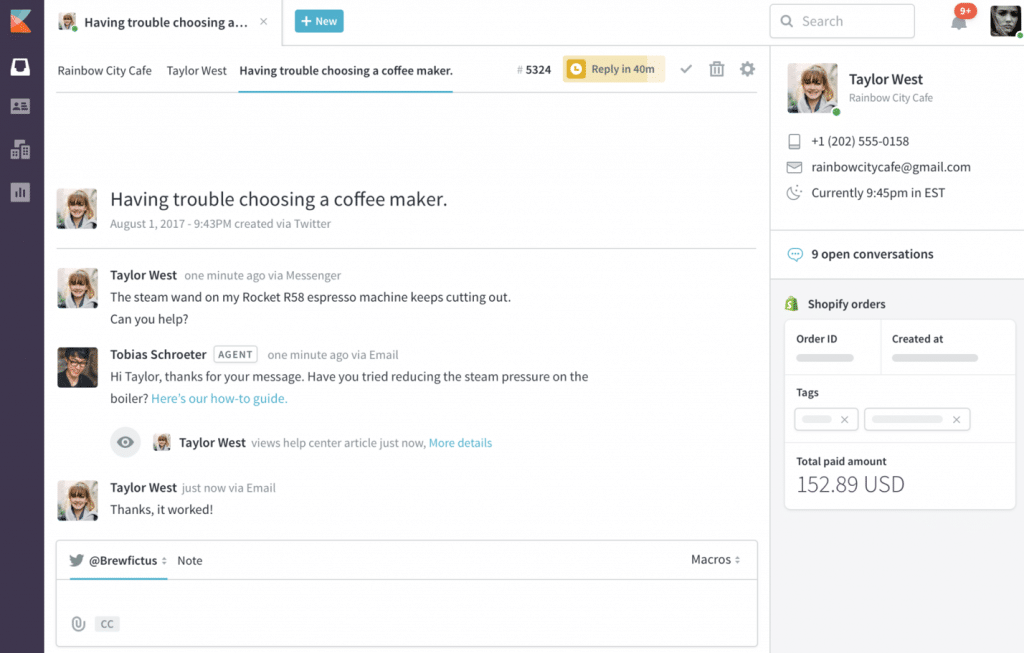
As customers demand more agile customer service, your small business has probably begun to feel the heat. When you’re busy going back and forth between customer emails, either speed or quality will probably take a hit. That’s where Kayako’s powerful help desk features come into play.
The software’s ability to track customer journeys and create user profiles gives you powerful context to provide high-quality support to every customer, fast. Plus, it has robust integrations that serve up even more comprehensive customer data, making sure you have the whole picture.
Imagine how much quicker and more effective your service can be when you have a holistic and complete view of the customer’s entire journey at your fingertips.
As a bonus, Kayako also allows you to tag your support tickets for easy organization as well as quickly assign ticket status. This helps you prioritize messages according to time targets, department, and importance. Although there are some quirky errors such as emails with large attachments sometimes failing to come through, there’s nothing that really breaks the software.
Live chat software
5. LiveChat
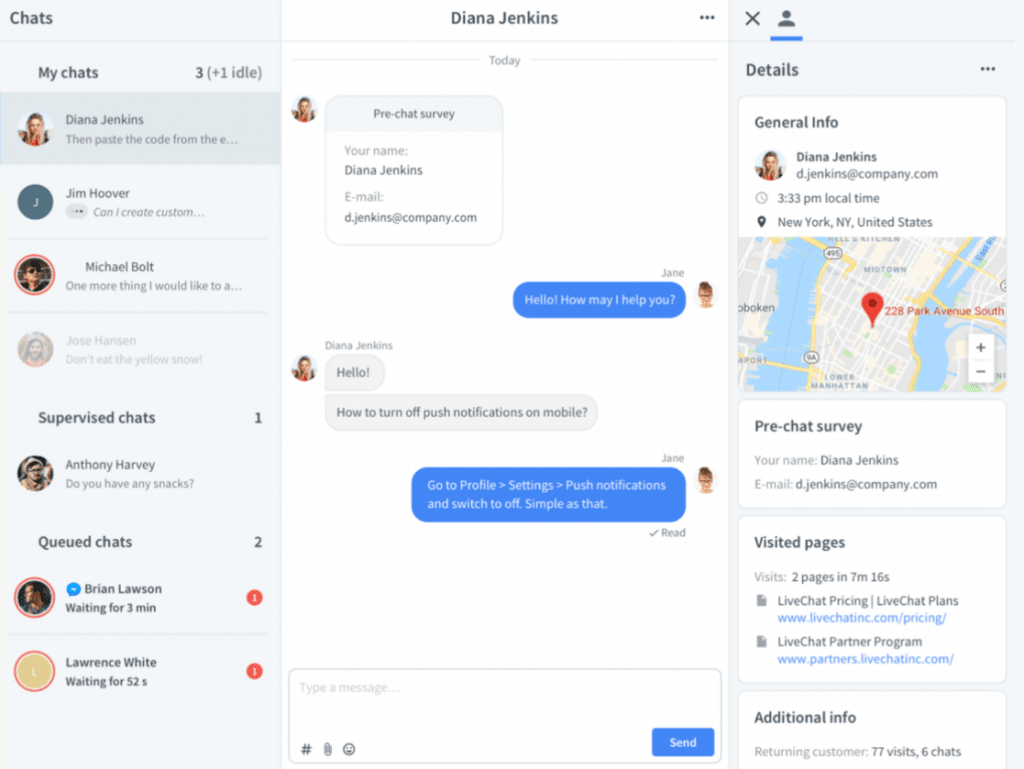
This live chat tool may not have the catchiest of names, but it definitely boasts functionality that can help you reshape your customer experience. On top of standard features like user profiles, saved responses, and auto messages, LiveChat can also route chats to relevant employees (like transfering technical questions to your IT person or product manager).
The software shows you your entire chat history with a customer so that you can reread a conversation or pick up a chat where you last left off—without everyone having to repeat themselves.
Other than that, LiveChat provides in-depth reports on customer satisfaction and service performance including response times and average chat duration. Chatbot customization tools are also there if you want to display your company logo in the software’s interface. Plus, the software can integrate with 170+ apps for even more extended functionality.
LiveChat is known for having a beautiful mobile app, but just keep in mind that it can’t be used for tasks like editing user profiles or customizing the backend interface of the tool.
6. Intercom
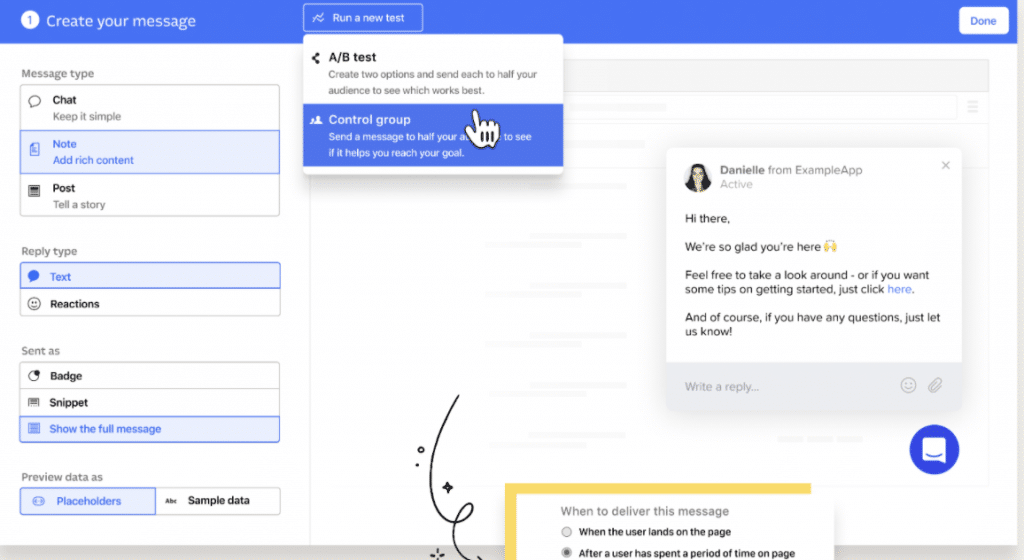
As one of the best customer service software programs, Intercom has more than 30,000 paying users across the globe. Its live chat feature is known for being a powerful resource for proactive support. The lntercom live chat widget has a UI that’s similar to the apps your customers use to communicate with family, friends, and coworkers. (Meaning it’s really easy to use and looks pretty.)
It also offers options to embed images, videos, and articles. People on both sides of the chat can attach files in the widget and even send emojis and GIFs.
With Intercom, you can also trigger automated chats based on user behavior and custom events. For instance, if someone views a specific number of pages on your site, you can trigger the chat widget immediately and engage with them at that precise moment. You can even create responses beforehand to answer the most commonly asked questions quickly. Plus, with Intercom’s smart bots, you can offer 24/7 customer service and free up some time to work on other important areas of your business.
Intercom has integrations with news portals, CRMs, and whatnot. (Bear in mind that some of the most useful features will cost you.)
How to choose a customer service software that’s right for you
1. Do an audit of your current capabilities and needs
Don’t be shy—write out the details of your current customer service situation. Include items like:
- All the systems and steps involved in your current customer service process
- The tech capabilities you have right now
- The human resources you have right now
- What your team is currently doing well (and struggling) with
- Your “must-haves”—the capabilities and/or resources you don’t have but you desperately need
- Your “nice-to-haves”—the capabilities and/or resources that would be super helpful, but aren’t critical
When you create a foundation to work with, it will be much easier to know what you’re looking for. This is especially helpful when you’re sorting through long lists of functionalities and prices for your new customer service software options.
2. Run each option through these 6 key areas
Every company has different needs, but there are six key areas that you should look at every time you evaluate a new customer service software option. Choose the ones that are most relevant and important to your organization:
- Features: Comb through the features list. How does it align with your internal customer service audit? Which features are critical and which can you afford to leave out?
- Customer experience: How do your customers seek service from you, and does that align with what the platform offers? You can’t afford to miss the mark on this one.
- Ease of use: While the software likely won’t be 100% intuitive right off the bat, make sure that your customers and your team will be able to navigate it with a relatively short learning curve.
- Reporting: Can you easily access performance data and share with your team? Without looking at past performance, it’s tough to improve in the future. So don’t skimp here.
- Scalability: Think of your growth. Can this new customer service software handle if you scale to double, triple, or 10x your current customer volume? Would it truly help your team and the customer experience at this volume?
- Automation: With scalability comes the urgent need for automated customer service. What capabilities does the new software have for reducing the need for human resources and maximizing efficiency?
3. Less is more—avoid choice paralysis / using too many tools
Especially when you’re on a budget, it might be tempting to choose several (seemingly) cheaper fragmented customer service software options. But if you don’t crunch the numbers beforehand, it might be a huge headache in the long run.
As a rule of thumb, try to consolidate your platforms wherever you can. This will mean shorter (and fewer) learning curves, less disparity in your data, and fewer opportunities for critical information to slip through the cracks.
There are loads of tools for customer service that also give you a wide range of other capabilities. For example, RingCentral lets you manage your remote customer service team, connect on multiple customer channels, and have a collaborative contact center—among others.
Don’t sell yourself short with a customer service software that makes things harder.
What’s the best customer service software for keeping your customers happy?
Having read all of this, you could be forgiven for feeling a little apprehensive. Perhaps you feel that it all sounds like a bit of a daunting task, or perhaps an unnecessary expense. However, you really can’t afford to put the customer experience on the back burner.
Today, the customer experience is more important than it’s ever been. It’s easier than ever before for customers to raise hell about bad experiences, or simply take their custom elsewhere. Combined, this can do a great deal of damage to your business and its reputation—and once reputational damage has been sustained, it’s hard to turn that around.
Simply cobbling your customer service functions together might (we must emphasize the might, here) serve you okay in the very early stages of getting your business up and running. Perhaps you’ll be able to get away with it for a time. But as you grow, you’ll need customer service solutions that make your customer service streamlined, smooth, and scalable.
There are, as we’ve discussed in this guide, many different customer service solutions on the market for you to choose from, and there are many opportunities to integrate them to cater to the unique needs of your business as it develops and expands. It’s up to you to make sure that you make the best possible use of them.The sooner you take advantage of these tools and start applying those all-important customer service best practices, the better equipped you’ll be to keep delighting your customers, time and again—and better still, you’ll be growing that vital bottom line.
Originally published Apr 16, 2020, updated Jun 19, 2024



